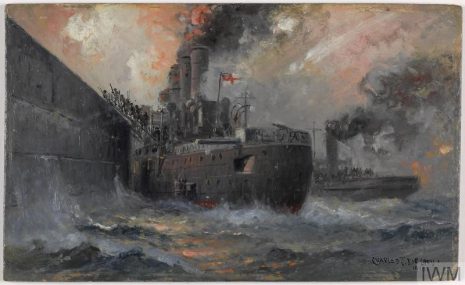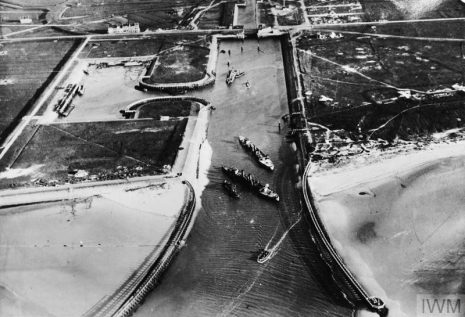The Zeebrugge Raid, April 23rd 1918
The decision to adopt, for the third time, unrestricted submarine warfare in February 1917 was predicated on the German belief and calculation that they could starve Britain into submission before the policy so outraged American opinion that it might bring then into the war as an effective British ally. The initial results of the campaign were startling, and in April 1917 alone 860,000 tons of merchant shipping was lost.
Such losses were irreplaceable, and the British Admiralty responded with the introduction of convoys as well as the development of various tactics aimed at limiting or even defeating the U-Boat. In addition, one of the aims, unrealised of course, of the 3rd battle of Ypres in 1917 was the capture of the Belgian ports which were used by U-Boats.
With the failure to advance by land, the Admiralty attempted to destroy the lock gates at Ostend and Zeebrugge by heavy shellfire from monitors; curious hybrid ships which were essentially small ships with one big battleship gun turret, they would need to fire at long range (12 or so miles) and to be successful would need wind, tide and visibility to favour the attack. It would also require successful co-ordination between aircraft spotters and ship gun aiming. It is perhaps not surprising that in 1917 the technology to co-ordinate such firing at this range proved impossible. Only a physical attack might block the entrances to these harbours.

© IWM (Art.IWM ART 871) The ‘Vindictive’ at Zeebrugge: The storming of Zeebrugge Mole by Charles John de Lacy
On St George’s Day 1918, a force of 1,700 men on board a collection of warships and converted ferries crossed the Channel to attack Zeebrugge and Ostend. It was a two-phase attack at Zeebrugge. Phase one involved an attack on the mole, or harbour wall, led by the cruiser HMS Vindictive. It, along with two ferries, landed men on the mole with the aim of neutralising German defences on it. A submarine packed with explosives was also planned to be exploded and destroy the viaduct linking the mole to the mainland. The attack would be obscured by a great smokescreen. Unfortunately, the wind changed direction, the smokescreen was lost, the Vindictive was spotted, and subsequently landed under great fire at the wrong spot, meaning its heavy guns could not be brought to bear on the enemy. The Royal Marines who landed on the mole suffered heavy casualties from the German gun batteries. The second phase involved an attempt to sink three elderly cruisers in the mouth of the harbour, behind the mole, and thereby block the ability of submarines to enter and leave the port. HMS Thetis, Intrepid and Iphigenia were hollowed out and filled with concrete. Both Intrepid and Iphigenia made it roughly into position, but not quite with sufficient precision to block the harbour for more than a few days. Great heroism was displayed, but ultimately the expedition did not achieve its objectives.

© IWM (Q 67725) German aerial photograph taken by German Reconnaissance aircraft on the morning after the historic Zeebrugge Raid of 24th April 1918.
Three Old Alleynians died in the raid:
At Dulwich 1897-1901. Brock was a member of the celebrated family firm of Brock’s Fireworks, which organized the extravagant displays at the Crystal Palace. He brought this expertise to the war, and served in the Royal Naval Air Service and on Lord Fisher’s Board of Invention and research. Most famously he devised the ‘Dover Flares’, a night-time illumination which was intended to force German U-Boats to dive while passing through the Straits of Dover, and thereby, it was hoped, hit the British-laid mines which were waiting for them. He also invented ‘Brock’s Bullet’, a specilised explosive bullet with a main composition being potassium chlorate. The priming mix was potassium chlorate and mercury sulphocyanide, and it was designed to shoot down Zeppelins, which early in the war cruised at such an altitude that no aircraft could reach them to shoot them down. He died leading a raiding party onto the mole.
At Dulwich 1893-97. Cordner joined the Royal Marines in 1899 and was an early expert in the field of wireless telegraphy. He served at Gallipoli and, in 1918, he was on board the Vindictive with the 4th Battalion Royal Marines preparing to land on the mole when he was killed by enemy shell fire.
At Dulwich 1895-97. One of six brothers at Dulwich (his brother Robert was also killed in the war, in June 1916 when his submarine was lost in the Baltic). Halahan joined the Royal Navy in 1897, and saw active serve during the Boxer Rebellion in China in 1900. He specialized in gunnery and commanded naval siege guns in Belgium in the early part of the war. He was killed leading a landing party at Zeebrugge.
Nick Black
Member of Staff, Dulwich College